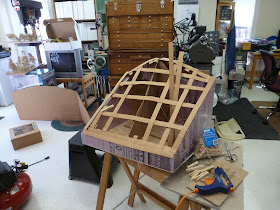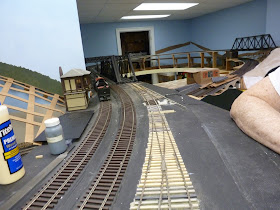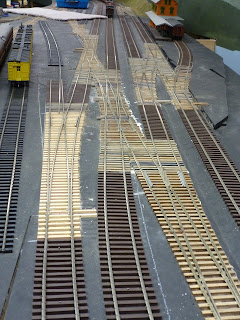So, we take our plug base to the workshop
I am going to use red foam for lightness and strength in the walls
I traced the sides of the box onto the red foam and have cut it with a knife to match. I bought some foam glue to assemble it.
Foam glue works but takes time to set. I used squares to ensure vertical walls while it dried.
Box is coming together. The diagonal wall is a pain but we get it together
He is the bottom half of the box. I had one foot wide pieces so I had to glue a second level on.
The other side
Here is the plug in the box so I can trace the upper sections of wall that I need.
Plug is complete. I have hot glued tabs for the webbing to attach to. I also added a cardboard center spine to hold he webbing on its long span.
Side view
I now have to complete the webbing of the hill. I added another cardboard rib to hold the webbing on a long span.
Webbing going in and tied to the box.
Plug is now getting its webbing.
Cross weave is in and trim pieces added along the side.
I have added the red rosin paper covering of the webbing.
It is tied into the previously built hillside.
The rosin paper certainly indicates the contours we will have in the area and how the pop up box will sit.
Looking back from the other end of the narrows.
Friday, March 30, 2018
Building that Pop Up
Well, no I have to address one scenery problem and that is the lack of access to the tracks going into the other section of the room. When I built the big mountain and the circular wall backdrop, I created about a 6 foot section of track that will not be able to be reached unless you climb on the scenery. So I need a pop up to get to this. So, I gathered my nail gun, glue and plywood to create a box through the scenery. I had to do this before I built the rest of the hill, while I could still reach it.
So, the box is taking shape - to match the topography we will create later with the plaster scenery.
Box is now done. I used the frame of the benchwork to provide a lip for the plug base to rest on.
The webbing will now have to be brought up to the box to incorporate it into the scenery.
Looking from the other room, you see the track entering the narrows and the access that the box provides. All this work and I used this access about once in 10 years - but just in case!
For the base of the plug, I used 1/8th inch thick plywood. I want this to be as light as possible. The grey piece of wood is a handle to hold it as you lift it up.
I spliced two pieces of scrap to make the part. It is a trapezoid due to the odd shape of the box. Having two pieces made cutting it much easier.
This is a side view of how I made the handle. That is a one by two on top of a one by one.
Box with plug inserted. Bow we have to build up the sides.
Plug resting on the frame rails
Plus set to slide in.
So, the box is taking shape - to match the topography we will create later with the plaster scenery.
Box is now done. I used the frame of the benchwork to provide a lip for the plug base to rest on.
The webbing will now have to be brought up to the box to incorporate it into the scenery.
Looking from the other room, you see the track entering the narrows and the access that the box provides. All this work and I used this access about once in 10 years - but just in case!
For the base of the plug, I used 1/8th inch thick plywood. I want this to be as light as possible. The grey piece of wood is a handle to hold it as you lift it up.
I spliced two pieces of scrap to make the part. It is a trapezoid due to the odd shape of the box. Having two pieces made cutting it much easier.
This is a side view of how I made the handle. That is a one by two on top of a one by one.
Box with plug inserted. Bow we have to build up the sides.
Plug resting on the frame rails
Plus set to slide in.
Tuesday, March 13, 2018
Monday Night Train Night
Well, the turnouts are in but now we have to make a transition from the escape turnout, down a hill to the yard level. You can see the turnout past my elbow where we have no track yet attached as we have about 5/16ths of height difference in the road bed between the main and the yard. So, we need to make a transition.
So, a visiting friend, Dan, was tasked with making that transition during the train night. It took him a lot of card stock but he did it over a distance of 30 inches and on a curve. Good Job, Dan!!
The rest of the gang was primarily working on incorporating a hatch into the scenery around the back of the big hill. Jim, a friend from the Baltimore area, was visiting to get some ideas for his new layout and was supervising.
The fellows are working with cardboard to do a mock up of what we need.
Meanwhile, Alan was patiently painting and coating plaster shoulders in the Snyderstown area.
Later, after things quieted down, I went in and used what the guys had done to lay out a plywood lined hatch.
The hatch sides mimic the roll of the hill side.
This will allow me to get to an area that would be inaccessible once the scenery is all in. I used 1/2 inch plywood as the sides. The cover will be made of expanded foam with a plaster coating.
I believe I will have to make the hatch top before I finish the plaster scenery so I can make it match. It would be difficult to do if the plaster is on the hill side.
This is the view from the other end of the curve. The cardboard line is the top of the declining hill.
So, a visiting friend, Dan, was tasked with making that transition during the train night. It took him a lot of card stock but he did it over a distance of 30 inches and on a curve. Good Job, Dan!!
The rest of the gang was primarily working on incorporating a hatch into the scenery around the back of the big hill. Jim, a friend from the Baltimore area, was visiting to get some ideas for his new layout and was supervising.
The fellows are working with cardboard to do a mock up of what we need.
Meanwhile, Alan was patiently painting and coating plaster shoulders in the Snyderstown area.
Later, after things quieted down, I went in and used what the guys had done to lay out a plywood lined hatch.
The hatch sides mimic the roll of the hill side.
This will allow me to get to an area that would be inaccessible once the scenery is all in. I used 1/2 inch plywood as the sides. The cover will be made of expanded foam with a plaster coating.
I believe I will have to make the hatch top before I finish the plaster scenery so I can make it match. It would be difficult to do if the plaster is on the hill side.
This is the view from the other end of the curve. The cardboard line is the top of the declining hill.
Finishing The East End Turnouts
Well, the double slip is in and now we have to lay another three turnouts on curves to tie in the Arrival/Departure tracks and a caboose track
The caboose track will go off to the left where you see the code 125 rail coming up. We also have to tie into the track to the right of that. It is the alternate lead to the Arrival track.
Looking back, I have laid two curved turnouts to both tie that Arrival track in and to put in an escape track to the turntable.
First we use the turnout template to determine what size frog I need to smoothly tie in the caboose track. It turns out that a number 8 will flow well with the leads.
I used a curve template to be sure that the minimum radius was maintained. I use 62 inches as a minimum. I also located the switch motor hole with the diagram. You can see the hole in the paper.
Ties are now glued down after I located and drilled the hole for the switch machine. I used the turnout template to do that. I use the steel rod and bar to hold the ties down while the glue sets.
An overhead view of the process.
I used the straight edge under the paper to give me a straight line template for the ties.
Then we have to sand the ties before starting to lay rails.
These are the leads into the Arrival tracks.
I laid a piece of flex track over the ties to be sure it flowed well.
Now I begin to lay the rail. The outer running rails go first. The frog is set based on the template.
Starting to put basic spikes in to hold the general shape of the turnout.
Frog goes pretty smoothly into place.
More rails added. I am building the turnout in Code 148 to match the main line. I will transition to Code 125 as we go into the yard about a foot down from the turnout.
Guard rails are in and the points are being bent to match the gauge.
Turnout is almost complete.
Now I have to accommodate the existing track and make the transition joint.
Ties are now trimmed and the turnout is essentially complete.
The throat is now almost done. I will finish the track and add the motor shortly. Everything will blend in color as I paint the track work.



























































